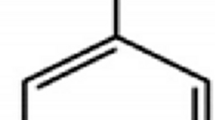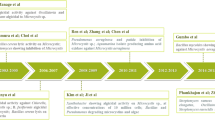Abstract
Harmful cyanobacterial blooms (HCB) have severe impacts on marine and freshwater systems worldwide. They cause oxygen depletion and produce potent cyanotoxins that have detrimental effects on human and environmental health and deteriorate the water quality. Biological treatment of the water for control of cyanobacterial blooms and removal of cyanotoxins can be a more economical and environment-friendly way, as they do not result in production of undesirable by-products. Most biological treatments of cyanobacteria and cyanotoxins have concentrated largely on bacteria, with little attention paid to algicidal fungi. Therefore, this review aims to provide an overview of the current status and the main progresses achieved in fungal biodegradation of HCB and cyanotoxin research. The available data revealed that 15 fungal species had high lytic activity against cyanobacteria, and 6 species were capable of degrading microcystins (MCs). Some fungal species (e.g., Aurobasidium pullulans and Trichoderma citrinoviride) have been identified to selectively inhibit the growth of cyanobacteria rather than beneficial species of other algal groups. Interestingly, some fungal strains (Trichaptum abietinum, Trichoderma citrinoviride) exhibited di-functional trait, being efficient in lysing cyanobacteria and degrading MCs released from the cells after decay. Beyond a comprehensive review of algicidal and toxin-degrading activities of fungi, this paper also identifies and prioritizes research gaps in algicidal fungi. The review also gives insights to the potential applications of algicidal fungi for removal of cyanobacterial blooms and their cyanotoxins from the aquatic environment.

Similar content being viewed by others
Change history
03 August 2021
A Correction to this paper has been published: https://doi.org/10.1007/s11356-021-15673-w
References
Azevedo SM, Carmichael WW, Jochimsen EM, Rinehart KL, Lau S, Shaw GR, Eaglesham GK (2002) Human intoxication by microcystins during renal dialysis treatment in Caruaru-Brazil. Toxicol 181-182:441–446
Balsano E, Esterhuizen-Londt M, Hoque E, Pflugmacher S (2015) Toxin resistance in aquatic fungi poses environmentally friendly remediation possibilities: a study on the growth responses and biosorption potential of Mucor hiemalis EH5 against cyanobacterial toxins. Int J Water Wastewater Treat 1:1–9
Bao ZY, Wu Y (2016) Biodegradation of microcystin-LR by an amino acid-degrading anaerobic bacterium. Desalin Water Treat 57:870–880
Best JH, Pflugmacher S, Wiegand C, Eddy FB, Metcalf JS, Codd GA (2002) Effects of enteric bacterial and cyanobacterial lipopolysaccharides, and of microcystin-LR, on glutathione S-transferase activities in zebra fish (Danio rerio). Aquat Toxicol 60:223–231
Chen W, Song L, Gan N, Li L (2006) Sorption, degradation and mobility of microcystins in Chinese agriculture soils: risk assessment for groundwater protection. Environ Pollut 144:752–758
Christoffersen K, Lyck S, Winding A (2002) Microbial activity and bacterial community structure during degradation of microcystins. Aquat Microb Ecol 27:125–136
Codd GA, Morrison LF, Metcalf JS (2005) Cyanobacterial toxins: risk management for health protection. Toxicol Appl Pharmacol 203:264–272
Dai W, Chen X, Wang X, Xu Z, Gao X, Jiang C, Deng R, Han G (2018) The Algicidal fungus Trametes versicolor F21a eliminating blue algae via genes encoding degradation enzymes and metabolic pathways revealed by transcriptomic analysis. Front Microbiol 9:826. https://doi.org/10.3389/fmicb.2018.00826
Esterhuizen-Londt M, Hertel S, Pflugmacher S (2017) Uptake and biotransformation of pure commercial microcystin-LR versus microcystin-LR from a natural cyanobacterial bloom extract in the aquatic fungus Mucor hiemalis. Biotechnol Lett 39:1537–1545
Han G, Feng X, Jia Y, Wang C, He X, Zhou Q, Tian X (2011) Isolation and evaluation of terrestrial fungi with algicidal ability from Zi** Mountain, Nan**g, China. J Microbiol 49:562–567
Han G, Ma H, Ren S, Gao X, He X, Zhu S, Deng R, Zhang S (2020) Insights into the mechanism of cyanobacteria removal by the algicidal fungi Bjerkandera adusta and Trametes versicolor. Microbiol Open 9:e1042. https://doi.org/10.1002/mbo3.1042
Hou X, Huang J, Tang J, Wang NA, Zhang LU, Gu L, Sun Y, Yang Z, Huang Y (2019) Allelopathic inhibition of juglone (5-hydroxy-1,4-naphthoquinone) on the growth and physiological performance in Microcystis aeruginosa. J Environ Manag 232:382–386
Hu X, Xu Y, Su HC, Xu WJ, Wang LH, Xu YN, Li ZJ, Yu-Cheng Cao YC, Wen GL (2019) Algicidal bacterium CZBC1 inhibits the growth of Oscillatoria chlorina, Oscillatoria tenuis, and Oscillatoria planctonica. AMB Express 9:144
Jia Y, Han G, Wang C, Guo P, Jiang W, LiX TX (2010) The efficacy and mechanisms of fungal suppression of freshwater harmful algal bloom species. J Hazard Mater 183:176–181
Jia Y, Wang C, Zhao G, Guo P, Tian X (2012a) The possibility of using cyanobacterial bloom materials as a medium for white rot fungi. Lett Appl Microbiol 54:96–101
Jia Y, Du J, Song F, Zhao G, Tian X (2012b) A fungus capable of degrading microcystin-LR in the algal culture of Microcystis aeruginosa PCC7806. Appl Biochem Biotechnol 166:987–996
Jones GJ, Bourne DG, Blakeley RL, Doelle H (1994) Degradation of the cyanobacterial hepatotoxin microcystin by aquatic bacteria. Nat Toxins 2:228–235
Kinley CM, Iwinski-Wood KJ, Geer TD, Hendrikse M, McQueen AD, Calomeni AJ, Liang J, Friesen V, Simair MC, Rodgers JH (2018) Microcystin-LR degradation following copper-based algaecide exposures. Water Air Soil Pollut 229:62
Li HX, Lu ZM, Zhu Q, Gong JS, Geng Y, Shi JS, Xu Z, Ma Y (2017a) Comparative transcriptomic and proteomic analyses reveal a FluG-mediated signaling pathway relating to asexual sporulation of Antrodia camphorata. Proteomics 17:1700256
Li J, Li R, Li J (2017b) Current research scenario for microcystins biodegradation – a review on fundamental knowledge, application prospects and challenges. Sci Total Environ 595:615–632
Luo J, Wang Y, Tang S, Liang J, Lin W, Luo L (2013) Isolation and identification of algicidal compound from Streptomyces and algicidal mechanism to Microcystis aeruginosa. PLoS One 8(10):e76444
Ma GX, Pei HY, Hu WR, Xu XC, Ma CX, Pei RT (2016) Effects of glucose on microcystin-LR removal and the bacterial community composition through anoxic biodegradation in drinking water sludge. Environ Technol 37:64–73
Massey IY, Yang F (2020) A mini review on microcystins and bacterial degradation. Toxins 12:268
Mohamed ZA (2016) Harmful cyanobacteria and their cyanotoxins in Egyptian fresh waters – state of knowledge and research needs. Afr J Aquat Sci 41:361–368
Mohamed ZA (2017) Macrophytes-Cyanobacteria allelopathic interactions and their implications for water resources management−a review. Limnol 63:122–132
Mohamed ZA, Al-Shehri AM (2013) Grazing on Microcystis aeruginosa and degradation of microcystins by the heterotrophic flagellate Diphylleia rotans. Ecotoxicol Environ Saf 96:48–52
Mohamed ZA, Hashem M, Alamri SA (2014) Growth inhibition of the cyanobacterium Microcystis aeruginosa and degradation of its microcystin toxins by the fungus Trichoderma citrinoviride. Toxicon 86:51–58
Mohamed ZA, Alamri S, Hashem M, Mostafa Y (2020) Growth inhibition of Microcystis aeruginosa and adsorption of microcystin toxin by the yeast Aureobasidium pullulans, with no effect on microalgae. Environ Sci Pollut Res Int 27:38038–38046
Nishu SD, Kang Y, Han I, Jung TY, Lee TK (2019) Nutritional status regulates algicidal activity of Aeromonas sp. L23 against cyanobacteria and green algae. PLoS One 14:e0213370
Ouyang L (2014) Enzymatic pathway for MCLR degradation by bacterium CJ5. Wuhan University of Technology, China (Master’s Thesis, in Chinese with English abstract)
Paerl HW, Huisman J (2008) Climate: blooms like it hot. Science 320:57–58
Paerl HW, Otten TG (2013) Harmful cyanobacterial blooms: causes, consequences, and controls. Microb Ecol 65:995–1010
Pflugmacher S, Wiegand C, Beattie KA, Codd GA, Steinberg C (1998) Uptake of the cyanobacterial hepatotoxin microcystin-LR by aquatic macrophytes. J Appl Bot 72:228–232
Pham T-L, Utsumi M (2018) An overview of the accumulation of microcystins in aquatic ecosystems. J Environ Manag 213:520–529
Redhead K, Wright SJ (1978) Isolation and properties of fungi that lyse blue-green algae. Appl Environ Microbiol 35(35):962–969
Ross C, Santiago-Vazquez L, Paul V (2006) Toxins release in response to oxidative stress and programmed cell death in the cyanobacterium Microcystis aeruginosa. Aquat Toxicol 78:66–73
Safferman RS, Morris M-E (1962) Evaluation of natural products for algicidal properties. Appl Microbiol 10:289–292
Saratale RG, Saratale GD, Chang JS, Govindwar PS (2009) Decolorization and biodegradation of textile dye Navy blue HER by Trichosporon beigelii NCIM-3326. J Hazard Mater 166:1421–1428
Schaeffer BA, Bailey SW, Conmy RN, Galvin M, Ignatius AR, Johnston JM, Keith DJ, Lunetta RS, Parmar R, Stumpf RP, Urquhart EA, Werdell PJ, Wolfe K (2018) Mobile device application for monitoring cyanobacteria harmful algal blooms using Sentinel-3 satellite ocean and land colour instruments. Environ Model Softw 109:93–103
Shao J, Li R, Lepo JE, Gu J-D (2013) Potential for control of harmful cyanobacterial blooms using biologically derived substances: problems and prospects. J Environ Manag 125:149–155
Van Wichelen J, Vanormelingen P, Codd GA, Vyverman W (2016) The common bloom-forming cyanobacterium Microcystis is prone to a wide array of microbial antagonists. Harmful Algae 55:97–111
Visser PM, Verspagen JMH, Sandrini G, Stal LJ, Matthijs HCP, Davis TW, Paerl HW, Huisman J (2016) How rising CO2 and global warming may stimulate harmful cyanobacterial blooms. Harmful Algae 54:145–159
Wang Q, Su M, Zhu W, Li X, Jia Y, Guo P, Chen Z, Jiang W, Tian X (2010) Growth inhibition of Microcystis aeruginosa by white-rot fungus Lopharia spadicea. Water Sci Technol 62:317–323
Yang J, Qiao K, Lv J, Liu Q, Nan F, **e S, Feng J (2020) Isolation and identification of two algae-lysing bacteria against Microcystis aeruginosa. Water 12:2485
Yuan XZ, Shi XS, Zhang DL, Qiu YL, Guo RB, Wang LS (2011) Biogas production and microcystin biodegradation in anaerobic digestion of blue algae. Energy Environ Sci 4:1511–1151
Zeng GM, Wang P, Wang Y (2015) Algicidal efficiency and mechanism of Phanerochaete chrysosporium against harmful algal bloom species. Algal Res 12:182–190
Zeng G, Gao P, Wang J, Zhang J, Zhang M, Sun D (2020) Algicidal molecular mechanism and toxicological degradation of Microcystis aeruginosa by white-rot fungi. Toxins 12:406
Zhang Y, **e HF (2012) Study on biodegradation of microcystin-LR by white-rot fungus S. commune. Environ Pollut Control J 34:56–60
Funding
The authors declare that funding received from the Deanship of Scientific Research- King Khalid University, Saudi Arabia, through General Research Program under grant number G.R.P.24/42, and from the European Union’s Horizon 2020 research and innovation program under the Marie Skłodowska-Curie grant agreement No 823860, were used in the design of the study and collection, analysis, and interpretation of data and in writing the manuscript.
Author information
Authors and Affiliations
Contributions
MH and SA collected and tabulated data of antialgal and toxin-degrading fungi. AC and VV participated in analysis and interpretation of the data. ZM participated in analysis and interpretation of the data, and was a major contributor in writing the manuscript. All authors read and approved the final manuscript.
Corresponding author
Ethics declarations
Ethics approval and consent to participate
Not applicable.
Consent for publication
Not applicable.
Conflict of interest
The authors declare no competing interests.
Additional information
Responsible Editor: Philippe Garrigues
Publisher’s note
Springer Nature remains neutral with regard to jurisdictional claims in published maps and institutional affiliations.
Rights and permissions
About this article
Cite this article
Mohamed, Z.A., Hashem, M., Alamri, S. et al. Fungal biodegradation and removal of cyanobacteria and microcystins: potential applications and research needs. Environ Sci Pollut Res 28, 37041–37050 (2021). https://doi.org/10.1007/s11356-021-14623-w
Received:
Accepted:
Published:
Issue Date:
DOI: https://doi.org/10.1007/s11356-021-14623-w




